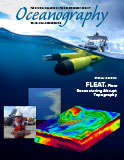Article Abstract
An impulsive or rotary wind stress can excite near-inertial oscillations (NIOs) in the surface mixed layer. Although previous work shows that coastal boundaries modify NIOs, few studies have explored their behavior near island topography. Understanding how topography modifies NIOs provides insight into physical processes that contribute to local mixing, which enhances biological richness near islands. Here, encounters between NIOs and the island chain of Palau are examined using moored current meter measurements from a 10-month field study. Near-inertial currents are surface intensified, where typical speeds of 0.15 m s−1 in the surface layer are twice those below 50 m. At moorings farthest from Palau topography, near-
inertial surface currents are intermittent and clockwise rotational, suggestive of wind-generated NIOs. Closer to the topography, near-inertial currents become more rectilinear, with enhanced energy at the northern and southern tips compared to along the north-south oriented coastline of the elongated island chain. The first empirical orthogonal function of near-inertial vector surface currents (62% of the total variance in the near-inertial band) reveals a broadly uniform flow that spans the northern and southern extents of the island, suggestive of a slab-like NIO response to wind stress, modified as the island topography blocks the flow. To further characterize the impact of the topography on near-inertial currents, a cluster of moorings at the northern tip of Palau is used to estimate vorticity, which increases as near-inertial current speeds increase. Near-inertial vorticity is attributed to frictional torque caused by the topographically enhanced near-inertial currents brushing against the northern tip of Palau.

